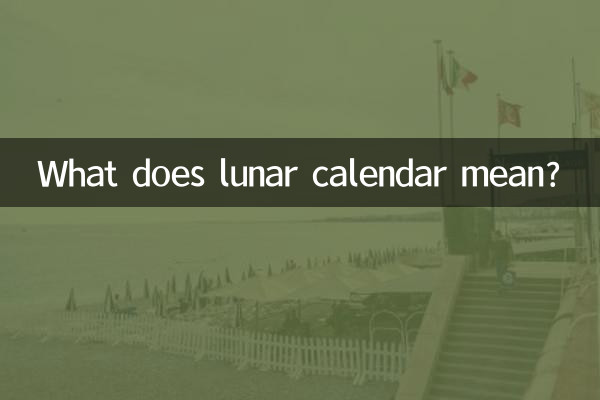What does lunar calendar mean?
In daily life, we often hear the terms "solar calendar" and "lunar calendar", especially when discussing festivals, birthdays or agricultural activities. So, what exactly do solar and lunar calendars mean? What's the difference between them? This article will give you a detailed analysis from the definition, origin, usage scenarios, etc.
1. Definition of solar calendar and lunar calendar

The solar calendar and the lunar calendar are two different calendar systems, based on the cycles of the sun and the moon respectively.
| Calendar type | definition | Base |
|---|---|---|
| solar calendar | A calendar based on the Earth's orbit around the sun (the tropical year). | sun movement |
| lunar calendar | A calendar based on the moon's orbit around the earth (the synodic months). | moon movement |
2. The origin of the solar calendar and the lunar calendar
The origins of the solar and lunar calendars can be traced back to ancient civilizations, with different cultures developing calendars that suit their own needs based on astronomical observations.
| Calendar type | origin | representative calendar |
|---|---|---|
| solar calendar | The ancient Egyptians were the first to use the Gregorian calendar, which was later improved by the Romans into the Julian calendar, and eventually evolved into the Gregorian calendar (Gregorian calendar) that is commonly used today. | Gregorian calendar (Gregorian calendar) |
| lunar calendar | Ancient Babylon and China were the first to use the lunar calendar. The Islamic calendar is a pure lunar calendar, while the traditional Chinese lunar calendar is a combined lunar and lunar calendar. | Islamic calendar, traditional Chinese lunar calendar |
3. The difference between the solar calendar and the lunar calendar
There are significant differences between the solar calendar and the lunar calendar in terms of calculation methods, year lengths, and month divisions.
| Comparative item | solar calendar | lunar calendar |
|---|---|---|
| Computing basics | Based on the movement of the sun, a year is approximately 365.2422 days. | Based on the movement of the moon, a month is approximately 29.53 days. |
| Year length | There are 365 days in an ordinary year and 366 days in a leap year (one leap year every 4 years). | There are about 354 days in a year, which is about 11 days less than the solar calendar. |
| Month division | Fixed to 12 months, with a fixed number of days per month (28-31 days). | Each month has 29 or 30 days, and a year has 12 or 13 months (leap months). |
| Use area | Globally applicable, international standard. | Mainly used for religious or traditional festivals (such as Islamic calendar, Lunar New Year). |
4. Application scenarios of solar calendar and lunar calendar
The solar calendar and the lunar calendar each have their own unique application values in different fields and cultures.
| Calendar type | Main application scenarios |
|---|---|
| solar calendar | Internationally used for daily life, business activities, legal documents, etc. |
| lunar calendar | Religious festivals (such as Islamic Ramadan), traditional festivals (such as Spring Festival, Mid-Autumn Festival), and agricultural activities (such as lunar solar terms). |
5. Hot topics and content on the entire network in the past 10 days
The following are some of the hotly discussed topics on the Internet in the past 10 days, combining the relevant content of the solar calendar and the lunar calendar:
| hot topics | Related content |
|---|---|
| Countdown to Spring Festival 2024 | Discuss the differences between the Lunar New Year (lunar calendar) and the Gregorian calendar dates, as well as holiday customs. |
| Leap months and lunar birthdays | Analyze the impact of leap months on birthdays in the lunar calendar and how to calculate birthdays in leap month years. |
| Solar terms and climate change | Discuss the relationship between lunar solar terms (such as the Beginning of Spring and Grain Rain) and agricultural production. |
| International Date Controversy | Compare the differences in use of the solar calendar and the lunar calendar in different cultures, such as Islamic countries and Western countries. |
6. Summary
The solar calendar and the lunar calendar are two different calendar systems, based on the cycles of the sun and moon respectively. As an internationally accepted calendar, the solar calendar is widely used in daily life and commercial activities; while the lunar calendar plays an important role in religious festivals, traditional celebrations and agricultural activities. Understanding the differences and connections between the two can help us better grasp time, plan life, and respect the traditional customs of different cultures.
Whether it is the solar calendar or the lunar calendar, they are the crystallization of human wisdom and reflect the exploration and respect for the laws of nature. In the future, these two calendars will continue to provide time references for the diverse cultures of human society.

check the details

check the details